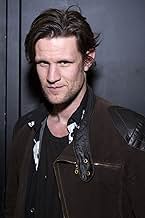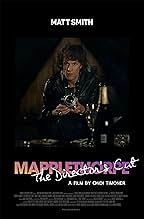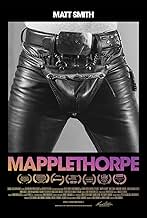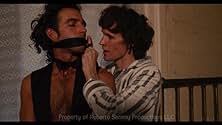Un regard sur la vie du photographe Robert Mapplethorpe de son ascension vers la gloire dans les années 1970 jusqu'à sa mort prématurée en 1989.Un regard sur la vie du photographe Robert Mapplethorpe de son ascension vers la gloire dans les années 1970 jusqu'à sa mort prématurée en 1989.Un regard sur la vie du photographe Robert Mapplethorpe de son ascension vers la gloire dans les années 1970 jusqu'à sa mort prématurée en 1989.
- Réalisation
- Scénario
- Casting principal
- Récompenses
- 8 victoires et 4 nominations au total
Karlee Leilani Perez
- Lisa Lyon
- (as Karlee Perez)
Avis à la une
Greetings again from the darkness. Writer-director Ondi Timoner goes head on (so to speak) with the story of Robert Mapplethorpe, the immensely talented and endlessly controversial photographer whose work in the 70's and 80's was often considered scandalous, if not pornographic. Ms. Timoner and star Matt Smith (PRIDE AND PREJUDICE AND ZOMBIES) are unflinching in this look at the artist, his personal life, and his work ... although I personally flinched a few times.
The opening scene is quite unusual as Mapplethorpe is shown alone in his small dorm room, attired in full Pratt Institute uniform, just prior to dropping out. We next see his NYC meet with Patti Smith (Marianne Rendon), and watch the two oddball youngsters connect. Their relationship develops as Robert shifts from drawing to photography, stating, "I'm an artist. I would have been a painter, but the camera was invented". The couple wriggles their way into the Chelsea Hotel and soon Mapplethorpe is focused on male nudes not just as artistic models, but also as personal pleasure. His interests send Patti Smith packing ... and understandably so.
Mapplethorpe's career takes off when Sam Wagstaff (John Benjamin Hickey) becomes his benefactor and lover. Sam's connections in the art world lead to gallery shows and work that Robert might never have attained. The film never shies away from Mapplethorpe's daddy issues, his promiscuity, his drug use, or his intolerance of those who didn't "get" his work. His fascination with male genitalia in both art and personal life is on full display, as many of his actual photographs are shown throughout.
Once diagnosed with HIV/AIDS, his sexual irresponsibility probably should have been emphasized, but other than that, filmmaker Timoner never tries to sugar coat the man. He seemed to crave attention, yet so many wanted love from him - Patti Smith, Sam Wagstaff, his father (Mark Moses, "Mad Men"), and his brother (who worked with him), all tried to establish that bond, but things just never quite clicked.
Other fine supporting work is provided by Hari Nef, Mickey O'Hagan (TANGERINE), Brian Stokes Mitchell, and Brandon Sklenar. Mapplethorpe's story would likely be best handled via documentary, but Mr. Smith's performance is worthy of attention. The film does a nice job of relaying the two sides to Mapplethorpe's work - the provocative and the portraits. He took some iconic photos of celebrities including the cover of Patti Smith's debut album "Horses".
Ms. Smith's 2010 memoir "Just Kids" paints a more complete picture of their relationship, and it's interesting to note that although he died in 1989, Mapplethorpe's work continues to generate emotional responses. In fact, his work inspired a national debate about whether the government should fund the arts. Ms. Timoner's film has been well received at LGBTQ festivals, and the Robert Mapplethorpe Foundation is devoted to protecting and promoting his work, while raising millions of dollars for AIDS research. His legacy is much more than some black and white photographs of nude models.
The opening scene is quite unusual as Mapplethorpe is shown alone in his small dorm room, attired in full Pratt Institute uniform, just prior to dropping out. We next see his NYC meet with Patti Smith (Marianne Rendon), and watch the two oddball youngsters connect. Their relationship develops as Robert shifts from drawing to photography, stating, "I'm an artist. I would have been a painter, but the camera was invented". The couple wriggles their way into the Chelsea Hotel and soon Mapplethorpe is focused on male nudes not just as artistic models, but also as personal pleasure. His interests send Patti Smith packing ... and understandably so.
Mapplethorpe's career takes off when Sam Wagstaff (John Benjamin Hickey) becomes his benefactor and lover. Sam's connections in the art world lead to gallery shows and work that Robert might never have attained. The film never shies away from Mapplethorpe's daddy issues, his promiscuity, his drug use, or his intolerance of those who didn't "get" his work. His fascination with male genitalia in both art and personal life is on full display, as many of his actual photographs are shown throughout.
Once diagnosed with HIV/AIDS, his sexual irresponsibility probably should have been emphasized, but other than that, filmmaker Timoner never tries to sugar coat the man. He seemed to crave attention, yet so many wanted love from him - Patti Smith, Sam Wagstaff, his father (Mark Moses, "Mad Men"), and his brother (who worked with him), all tried to establish that bond, but things just never quite clicked.
Other fine supporting work is provided by Hari Nef, Mickey O'Hagan (TANGERINE), Brian Stokes Mitchell, and Brandon Sklenar. Mapplethorpe's story would likely be best handled via documentary, but Mr. Smith's performance is worthy of attention. The film does a nice job of relaying the two sides to Mapplethorpe's work - the provocative and the portraits. He took some iconic photos of celebrities including the cover of Patti Smith's debut album "Horses".
Ms. Smith's 2010 memoir "Just Kids" paints a more complete picture of their relationship, and it's interesting to note that although he died in 1989, Mapplethorpe's work continues to generate emotional responses. In fact, his work inspired a national debate about whether the government should fund the arts. Ms. Timoner's film has been well received at LGBTQ festivals, and the Robert Mapplethorpe Foundation is devoted to protecting and promoting his work, while raising millions of dollars for AIDS research. His legacy is much more than some black and white photographs of nude models.
Award-winning documentarian Ondi Timoner (Dig!) creates her first fiction feature as an episodic ramble, rather than a wild ride. Ticking off famous encounters - an affair with Marianne Rendón's Patti Smith, his careermaking partnership with gay curator Sam Wagstaff (John Benjamin Hickey) - the script feels like a dutiful life-list, its dialogue creakily banal ("You're the Jekyll and Hyde of photography!"). Shot quickly, and on a small budget, the action's confined to stylish interiors, which gives it a shut-in feeling. Smith throws himself gamely into the part, but his languid performance can't spark the movie into life, even when drugs, Aids and heartbreak kick in. Set against Mapplethorpe's taboo-busting work, this homage feels oddly conventional, though it never swerves his hedonistic nightlife. Curious art lovers can check out 2016 doc Robert Mapplethorpe: Look At The Pictures for a smarter, spicier take on his fine work and fast times.
If this was a mainstream cinema release rather than a Gay film festival movie I suspect Matt Smith would have been included in all the major acting nominees for this years awards.
Matt Smit gives an amazing performance as Michael Mapplethorpe the famous art photographer for the late 1960's 1970's.
Of course he was a cultural gay icon and the movie does show his famous male erotic photos as well as the beautiful floral subjects he also photographed. It was the era in New York if promiscuous sex when thousands of men died of AIDS including Mapplethorpe who died in 1989 age 42.
Mapplethorpe says in the movie That he wouldn't reach the age of 50 but he hoped he'd be famous before he dies and he was correct on both counts.
The film won 7 audience awards at International Film Festivals and it's easy to understand why as Director Ondi Timoner and the great supporting cast especially Marianne Rendon as Patti Smith and Brandon Sklenar as Edward Mapplethorpe Roberts brother have contributed to make a very interesting and entertaining movie that should be seen by all just not the GLBTQI audiences.
If male erotic nudity in photography or mild homosexual sexual content offends this movie is not for you but as I watched this film I thought of all explicit heterosexual sexual content in films our community sits through and it made me think if one day so called GLBTQ movies will be shown alongside mainstream movies and therefore gain a much wider audience. I also wondered watching Mapplethorpe if the Art and Photography of that amazing psychedelic era of Mapplethorpe and Andy Warhol would be viewed as such valuable masterpieces if created today but I guess it's like saying that if a painter today painted like a renaissance master like Leonard Da Vinci or Michelangelo would we think it old fashioned ? We watched Matt Smith yesterday play another famous Gay cultural icon Christopher Isherwood in his 2011 movie Christopher and His Kind in which he plays another very different gay man and I agree with his stance of defending straight actors who play gay characters as far as I'm concerned it's the best actor to suit the part regardless of sexuality and Matt Smith I think is perfect in this role. Hi see it or catch it on DVD or stream release.
Of course he was a cultural gay icon and the movie does show his famous male erotic photos as well as the beautiful floral subjects he also photographed. It was the era in New York if promiscuous sex when thousands of men died of AIDS including Mapplethorpe who died in 1989 age 42.
Mapplethorpe says in the movie That he wouldn't reach the age of 50 but he hoped he'd be famous before he dies and he was correct on both counts.
The film won 7 audience awards at International Film Festivals and it's easy to understand why as Director Ondi Timoner and the great supporting cast especially Marianne Rendon as Patti Smith and Brandon Sklenar as Edward Mapplethorpe Roberts brother have contributed to make a very interesting and entertaining movie that should be seen by all just not the GLBTQI audiences.
If male erotic nudity in photography or mild homosexual sexual content offends this movie is not for you but as I watched this film I thought of all explicit heterosexual sexual content in films our community sits through and it made me think if one day so called GLBTQ movies will be shown alongside mainstream movies and therefore gain a much wider audience. I also wondered watching Mapplethorpe if the Art and Photography of that amazing psychedelic era of Mapplethorpe and Andy Warhol would be viewed as such valuable masterpieces if created today but I guess it's like saying that if a painter today painted like a renaissance master like Leonard Da Vinci or Michelangelo would we think it old fashioned ? We watched Matt Smith yesterday play another famous Gay cultural icon Christopher Isherwood in his 2011 movie Christopher and His Kind in which he plays another very different gay man and I agree with his stance of defending straight actors who play gay characters as far as I'm concerned it's the best actor to suit the part regardless of sexuality and Matt Smith I think is perfect in this role. Hi see it or catch it on DVD or stream release.
"Apparently too complaisant to earn approval from the Robert Mapplethorpe Foundation, Timoner, a documentarian herself,
dulls the edge of Mapplethorpe's thornier elements, instead, the Robert her film portrays is an amorphous mass of petulance, narcissism and ambiguity, neither drive nor ruthlessness can be traced from Smith's performance. As if things, homosexuality, BDSM, a Polaroid camera, a sugar daddy in the person of Sam Wagstaff (an affable Hickey), among others, simply happen to this nonentity, and he take them willy-nilly. Also, Marianne Rendón's Patti Smith is equally bland, a disgrace to an iconic figure. Contrary to Mapplethorpe's explosively erotic works, the biopic is too nondescript to make a splash anywhere, save for the 16mm film texture that is alluringly pleasing to contemplate, however, the sheen loses some of its flavor and turns bilious when the film careers toward its destined finish line. The director's cut, released in 2020, runs several minutes longer by interleaving scenes that fumble for some religious influence on Mapplethorpe's anima and artistic inspiration, a fool's errand to inject some semblance of meaningfulness to a picture largely skims on the surface of a controversial figure."
-
-
Matt Smith is woefully miscast as Mapplethorpe, but the story and the dialogue don't do him any favours. This is not the Mapplethorpe of "Just Kids" or any interview that I have read. The production seems scared of itself and really brushes over sensitive subjects rather than take them on headlong. Mapplethorpe's story deserves a better telling than this.
Le saviez-vous
- AnecdotesThe film was shot in only nineteen days.
- GaffesAfter dinner with his parents, during the scene when Robert photographs the knife and the flower the knife is held in place by a "Mathellini" clamp. The original Cardellini wasn't invented until the 1990s, after Robert's death.
- Versions alternativesA longer 114 minute director's cut version was released in 2020. It features additional footage (with more scenes focusing on Mapplethorpe's childhood) and an alternate soundtrack.
- ConnexionsReferences Macadam cowboy (1969)
- Bandes originalesShake Shake Shake
Performed by William Bollinger
Written by William Bollinger
Courtesy of Simply Grand Music
Meilleurs choix
Connectez-vous pour évaluer et suivre la liste de favoris afin de recevoir des recommandations personnalisées
- How long is Mapplethorpe?Alimenté par Alexa
Détails
- Date de sortie
- Pays d’origine
- Site officiel
- Langue
- Aussi connu sous le nom de
- The Perfect Moment
- Sociétés de production
- Voir plus de crédits d'entreprise sur IMDbPro
Box-office
- Montant brut aux États-Unis et au Canada
- 91 002 $US
- Week-end de sortie aux États-Unis et au Canada
- 17 000 $US
- 3 mars 2019
- Montant brut mondial
- 91 002 $US
- Durée
- 1h 42min(102 min)
- Couleur
- Rapport de forme
- 1.85 : 1
Contribuer à cette page
Suggérer une modification ou ajouter du contenu manquant








































